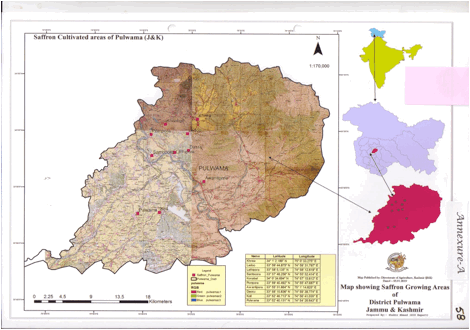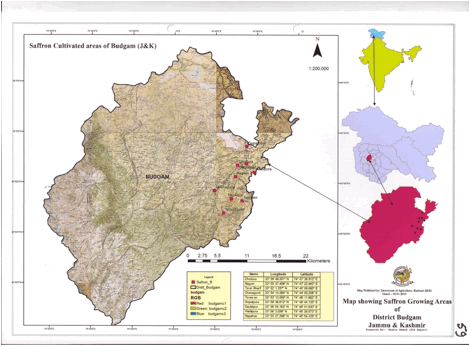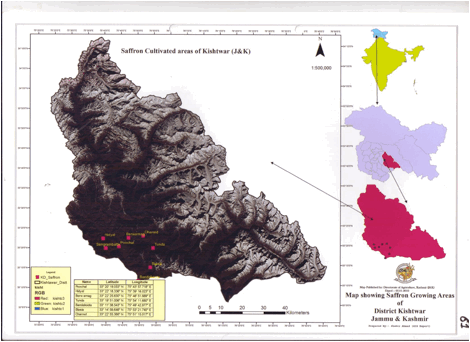
India International Kashmir Saffron Trading Centre (IIKSTC)
Directorate of Agriculture Production and Farmers Welfare
(Government of Jammu and Kashmir)

Directorate of Agriculture Production and Farmers Welfare
(Government of Jammu and Kashmir)
The details of project are as under:
Total Project cost: 400.11 Crore
Sanctioned Project Cost: 400.11 Crore
Govt. of India Share: 315.99 Crore
Farmers Share: 84.12 Crore
Period: 9 years (2010-2020)
Funds released as on date 266.1023 Crore
Expenditure as on date: 256.3535 Crore
Project Partners for implementation for National mission on Saffron:
Objectives of the Mission are as under:
Major Components under National Mission on Saffron:
An area of 3715 hectares of Saffron is proposed to be rejuvenated under the mission in phased manner out of which 2578.75 hectares stands rejuvenated as on date, the details are as under.
| S. No | District | Target (Ha) | Achievement as on date |
| 01 | Pulwama | 3200.00 | 2035.75 |
| 02 | Budgam | 300.00 | 328.000 |
| 03 | Srinagar | 165.00 | 165 |
| 04 | Kishtawar | 50.00 | 50.000 |
| Total | 3715.00 | 2578.75 | |
The production of saffron is an outcome of biological activity which is highly sensitive to changes in weather. The important weather vagaries such as excessive rainfall, temperature, humidity, wind etc. influence the biological process directly or indirectly. For Instance, low soil moisture due to poor precipitation adversely affects corm multiplication resulting in reduced plant density and poor precipitation during growth period results in stunted plant growth which ultimately affects the crop yield/productivity.
Excessive rainfall during early growth cycle period damages corms. Fluctuation in temperature during the crop cycle causes outbreak of pests and diseases. All these abnormal factors results either in partial loss of yield or in complete crop failure which reduces income of farmers. The deviations of weather variables from the normal adversely affected the crop yields and the income, therefore the Department is vigorously motivating the farmers to adopt scientific methods of Saffron Cultivation for higher biological yields i.e. 7.5 Kg/ha which will result in the socio-economic up-liftment of Saffron growers, excess revenue generation, and importantly the State of J&K will maintain the legacy of producing world’s best saffron which is being pursued by way of implementing approved components under Saffron Mission.
Over the years, there has been substantial increase in the crop yields recorded for the areas rejuvenated under National Mission on Saffron from 1.88 kg/ha to 4-5 kg/ha.
Past trend in area, production and productivity of saffron
| Year | Area(In Ha) | Production(In M. Ts) | Yield (Kg/ha) |
| 1996-97 | 5707 | 15.95 | 2.80 |
| 1997-98 | 4618 | 13.39 | 2.90 |
| 1998-99 | 4116 | 12.88 | 3.13 |
| 1999-2000 | 3997 | 7.65 | 1.89 |
| 2000-2001 | 2831 | 3.59 | 1.27 |
| 2001-2002 | 2713 | 0.30 | 0.095 |
| 2002-03 | 2825 | 6.50 | 2.28 |
| 2003-04 | 2742 | 5.15 | 1.88 |
| 2004-05 | 3143 | 6.86 | 2.23 |
| 2005-06 | 3010 | 6.50 | 2.15 |
| 2006-07 | 3280 | 8.20 | 2.50 |
| 2007-08 | 3280 | 7.70 | 2.34 |
| 2008-09 | 3715 | 9.462 | 2.50 |
| 2009-2010 | 3715 | 10.40 | 2.75 |
Comparative trends in area, production and productivity of saffron
|
Year |
Rejuvenated under NSM (ha) | Rejuvenated Cumulative Total (area in ha) |
Average yield of rejuvenated area (Kg/ha) | Area sown by the Growers under traditional method (in ha) | Average yield under traditional method (Kgs/ha) |
|
2010-11 |
- | - | - | 3715 | 2.70 |
|
2011-12 |
331 | 331 | 4.5 | 3384 | 2.75 |
|
2012-13 |
943 | 1274 | 4.5 | 2441 | 2.75 |
|
2013-14 |
528 | 1802 | 4.8 | 1913 | 2.80 |
|
2014-15 |
157 | 1959 | 1.5 (Floods) | 1756 | 1.5 (Floods) |
|
2015-16 |
176 | 2135 | 5.50 | 1580 | 2.80 |
|
2016-17 |
79.81 | 2214.81 | 5.49 | 1497 | 2.85 |
|
2017-18 |
172.90 | 2387.71 | 1.64 | 1323.75 | 0.0973 |
|
2018-19 |
74.29 | 2462 | 1.75 | 1253 | 1.08 |
|
2019-20 |
116.75 (Liability of previous years) | 2578.75 | 4.7 | 1136.25 | 2.54 |
Production/Productivity of Saffron under National Mission on Saffron
| Year | Total Area | Rejuvenated Cumulative Total (area in ha) |
Total area under traditional method
|
Total Production Rejuvenated area (MTs) |
Total production inclusive from non-traditional areas (MTs) |
Total Productivity (Kgs/ha) |
| 2010-11 | 3715 | - | 3715 | - | 10.03 | 2.69 |
| 2011-12 | 3715 | 331 | 3384 | 1.489 | 10.79 | 2.90 |
| 2012-13 | 3715 | 1274 | 2441 | 5.733 | 12.445 | 3.34 |
| 2013-14 | 3715 | 1802 | 1913 | 8.649 | 14.005 | 3.77 |
| 2014-15 | 3715 | 1959 | 1756 | 2.938 | 5.572 | 1.5 (Floods) |
| 2015-16 | 3715 | 2135 | 1580 | 11.742 | 16.166 | 4.35 |
| 2016-17 | 3715 | 2218 | 1497 |
12.19 |
16.45 | 4.42 |
| 2017-18 | 3715 | 2387.81 | 1323.75 | 3.92 | 5.2 | 1.4 |
| 2018-19 | 3715 | 2462 | 1253 | 4.30 | 5.653 | 1.52 |
| 2019-20 | 3715 | 2578.75 | 1136.25 | 12.495 | 15.12 | 4.07 |
Orthodox mindset of farmers have been swayed successfully and the farmers resorted to adopt scientific methodology for promoting saffron cultivation as bold initiatives like prophylactic measures and soil health reclamation measure are being taken which is a game changer in Saffron cultivation with the application of 10.88 T/ha organic manure to the soil for promoting saffron crop production program.
Furthermore, mechanization of Saffron fields has brought down labour cost as the department has distributed Weeders to the Saffron Growers who are shifting towards Scientific methods of Saffron cultivation.
Saffron crop requires irrigation at critical stages of crop growth therefore, National Saffron Mission provides a lasting solution for overcoming the water deficit by exploring 128 number of deep production wells which shall be connected with sprinkler system and each sprinkler system does have command of 26-30 ha which will augment the water supply for the saffron crop at its critical stages and will revolutionize the Saffron production/ productivity in Jammu and Kashmir State. The Physical progress under irrigation component is as under:
| S. No |
Particulars |
Total target |
Total achievements |
|
01 |
Production Wells |
126 |
120, 04 under progress |
|
02 |
Production wells in private sector |
02 |
02 |
|
Total |
128 |
122, 04 under progress |
|
|
03 |
Providing of Sprinkler system |
128 |
22 completed, 106 Handover/Takeover process under progress |
Saffron crop requires irrigation at critical stages of crop growth, therefore, National Saffron Mission provides a lasting solution for overcoming the water deficit requirement be exploring 128 number of Deep Production wells which shall be connected with sprinkler system and each sprinkler system does have command of 26-30 ha which will augment the water requirement of the saffron crop at its critical stages and will revolutionize the saffron production/productivity in Jammu and Kashmir State and production will get increased and will get registered 8.5 Kg/ha. The Mechanical Engineering Department (MED) as of now has completed only 05 Sprinkler system as on date and the work on rest of the bore-wells shall be connected with the Sprinkler System in Mission Mode so that the same is completed at an earliest.
India International Kashmir Saffron Trading Center (IIKSTC) at Dussu, Pampore
Government of India, Geographical Indication Registry under Geographical Indication of Goods (Registration and Protection) Act, 1999 has been pleased to accord Certificate of Registration of Geographical Indication for Saffron produced in J&K.
Saffron produced at farmer fields in the state of Jammu and Kashmir is of best quality which proffers strong flavour, aroma and colour-effect in comparison to Saffron produced across the world and it reaches the market through network of intermediaries who frequently exploit the growers, therefore, a need was felt to maintain the identity of Kashmir Saffron and to eliminate the role of intermediaries from the marketing channel for better pricing for growers in the domestic and international market which will eventually help growers in realize maximum prices which otherwise as on date is a under-priced commodity in the national and international market.
In this endeavor to increase the demand of saffron grown in the State of Jammu and Kashmir, there was a need for evolving a brand for Kashmir Saffron and in this regard Government of India extended a helping hand so that all marketing solutions would be provided to the farmer under one roof and branding of Kashmiri Saffron would be a step towards quality assurance.
The Spice Park/IIKSTC has been constructed under National Saffron Mission at Dussu Pampore. IIKSTC has been constructed at an estimated cost of Rs. 37.81 Crore by National Horticulture Board, GoI and is currently being run by the Department of agriculture,Kashmir.
Further, the e-marketing centre is functional.
E-auction Center


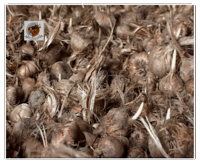
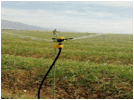
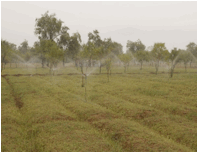
Various post harvest practices:
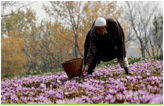
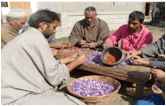





Maps regarding cultivation of Saffron In J&K:
